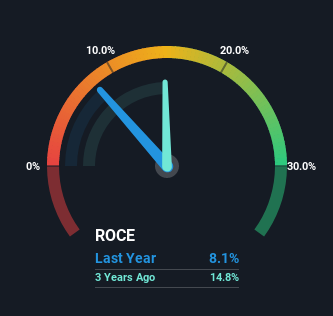Returns On Capital Signal Tricky Times Ahead For Smith & Nephew (LON:SN.)
If we want to find a potential multi-bagger, often there are underlying trends that can provide clues. In a perfect world, we'd like to see a company investing more capital into its business and ideally the returns earned from that capital are also increasing. Put simply, these types of businesses are compounding machines, meaning they are continually reinvesting their earnings at ever-higher rates of return. Having said that, from a first glance at Smith & Nephew (LON:SN.) we aren't jumping out of our chairs at how returns are trending, but let's have a deeper look.
What is Return On Capital Employed (ROCE)?
Just to clarify if you're unsure, ROCE is a metric for evaluating how much pre-tax income (in percentage terms) a company earns on the capital invested in its business. The formula for this calculation on Smith & Nephew is:
Return on Capital Employed = Earnings Before Interest and Tax (EBIT) ÷ (Total Assets - Current Liabilities)
0.081 = US$712m ÷ (US$11b - US$2.1b) (Based on the trailing twelve months to December 2021).
Thus, Smith & Nephew has an ROCE of 8.1%. In absolute terms, that's a low return but it's around the Medical Equipment industry average of 9.8%.
Check out our latest analysis for Smith & Nephew
In the above chart we have measured Smith & Nephew's prior ROCE against its prior performance, but the future is arguably more important. If you'd like, you can check out the forecasts from the analysts covering Smith & Nephew here for free.
What The Trend Of ROCE Can Tell Us
When we looked at the ROCE trend at Smith & Nephew, we didn't gain much confidence. Around five years ago the returns on capital were 15%, but since then they've fallen to 8.1%. However, given capital employed and revenue have both increased it appears that the business is currently pursuing growth, at the consequence of short term returns. And if the increased capital generates additional returns, the business, and thus shareholders, will benefit in the long run.
The Key Takeaway
In summary, despite lower returns in the short term, we're encouraged to see that Smith & Nephew is reinvesting for growth and has higher sales as a result. In light of this, the stock has only gained 4.3% over the last five years. Therefore we'd recommend looking further into this stock to confirm if it has the makings of a good investment.
While Smith & Nephew doesn't shine too bright in this respect, it's still worth seeing if the company is trading at attractive prices. You can find that out with our FREE intrinsic value estimation on our platform.
If you want to search for solid companies with great earnings, check out this free list of companies with good balance sheets and impressive returns on equity.
Have feedback on this article? Concerned about the content? Get in touch with us directly. Alternatively, email editorial-team (at) simplywallst.com.
This article by Simply Wall St is general in nature. We provide commentary based on historical data and analyst forecasts only using an unbiased methodology and our articles are not intended to be financial advice. It does not constitute a recommendation to buy or sell any stock, and does not take account of your objectives, or your financial situation. We aim to bring you long-term focused analysis driven by fundamental data. Note that our analysis may not factor in the latest price-sensitive company announcements or qualitative material. Simply Wall St has no position in any stocks mentioned.

 Yahoo Finance
Yahoo Finance 
